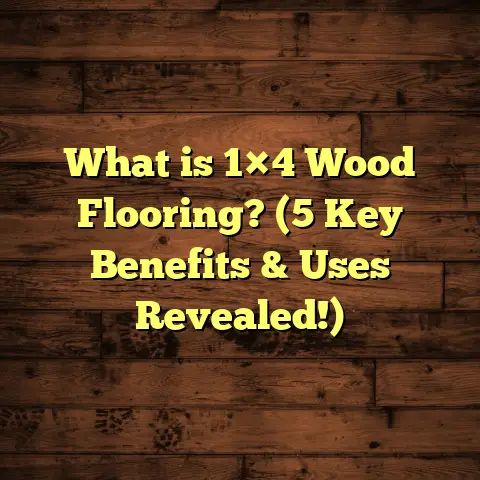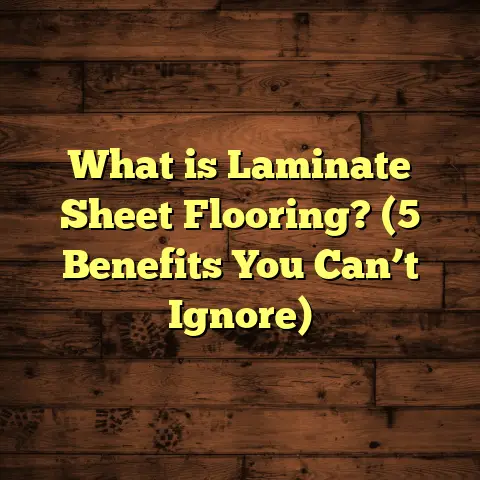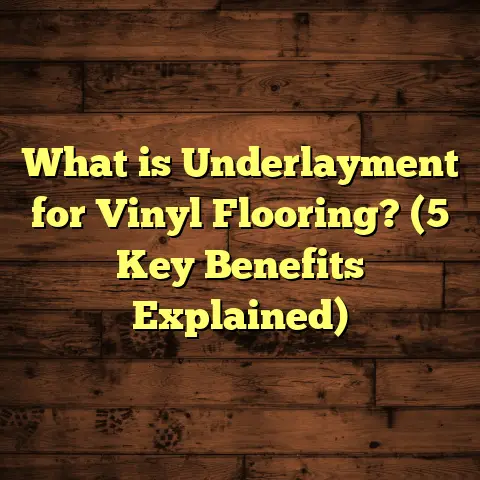What is Floor Paint? (5 Benefits You Didn’t Know About!)
Spring always brings this fresh energy to my home. As the days get longer and the sun peeks through the windows, I find myself wanting to refresh my space in ways I haven’t thought about all winter. Recently, I spent several weekends working on my floors—yes, floors! It’s funny how floors are often the last thing on our minds when redecorating, but they really set the tone for a room. This time around, I tried something I’d been curious about for years: floor paint. If you’re scratching your head wondering what floor paint is and why anyone would want to paint their floors instead of installing new ones, stick with me. I’ll share everything I’ve learned—from the basics to benefits you probably haven’t heard about.
What is Floor Paint?
Floor paint is a special type of paint designed specifically for coating floors. Unlike the paint used on walls or ceilings, floor paint is formulated to withstand foot traffic, abrasions, spills, and sometimes even harsh weather conditions. You can use it on a variety of surfaces including concrete, wood, metal, and even some types of tile.
The Science Behind Floor Paint
What makes floor paint different? It’s all about durability and adhesion. Floor paints often contain epoxy or polyurethane resins that create a tough, protective layer once cured. Epoxy-based floor paints are especially popular in industrial and garage settings because they resist chemicals, oil stains, and chipping.
Acrylic and latex floor paints are water-based, making them easier to apply and clean up but generally less durable than epoxy. These are great for patios or indoor rooms with lighter foot traffic.
Here’s a quick comparison:
| Type | Best For | Durability | Drying Time | Typical Cost (Materials only) |
|---|---|---|---|---|
| Epoxy Paint | Garages, basements, warehouses | 5-10 years | 24-72 hours (full cure) | $30-$80 per gallon |
| Acrylic Paint | Patios, porches, indoor floors | 2-3 years | 1-2 hours | $20-$50 per gallon |
| Latex Paint | Wood floors, low traffic areas | 3-5 years | 1-2 hours | $15-$40 per gallon |
When I first started using floor paint about 8 years ago, epoxy was my go-to for high-traffic areas. It requires mixing two parts—the resin and hardener—which can seem intimidating at first but the results are worth it.
Types of Surfaces You Can Paint
I experimented on various surfaces:
- Concrete: The most common surface for floor paint. Garages, basements, patios—all perfect candidates.
- Wood: Hardwood floors can be painted but require careful prep like sanding and priming.
- Metal: Industrial settings might have metal floors or stairs that benefit from epoxy coatings.
- Tile: Some types of tile can be painted with the right primer and paint; good for updating old ceramic tiles without replacement.
The key is surface preparation. Cleaning, repairing cracks or chips, and sanding rough patches ensures the paint sticks well and lasts longer.
Why Choose Floor Paint? Five Benefits You Didn’t Know About
I’ve shared floor painting stories with friends many times. Most people think it’s just a cheap way to make floors look colorful temporarily. But there’s much more to it than meets the eye.
1. Transform Your Space on a Budget
One of the biggest surprises for me was how floor paint can change a room without breaking the bank.
Take garages for instance. Replacing a garage floor with polished concrete or tiling can cost upwards of $10-$20 per square foot installed. For a typical two-car garage around 400 square feet, that easily hits $4,000-$8,000.
Painting the same garage with epoxy floor paint costs roughly $2-$5 per square foot for materials if you do it yourself. Hiring a professional adds labor costs but still usually stays below $7-$10 per square foot total.
I painted my own garage floor last spring over two days for about $500—materials and supplies included. The transformation was dramatic: from dull gray concrete to a shiny, glossy blue floor that felt like it belonged in a showroom.
And it’s not just garages. Basements, concrete patios, even wooden porches can get a fresh look without tearing out existing flooring.
2. Longevity That Exceeds Expectations
Durability was my next big discovery. Early on, I assumed painted floors would chip or wear quickly under foot traffic.
But epoxy floor paints cure into a hard shell that resists scratches, stains, and impacts surprisingly well. In fact, industrial facilities rely on epoxy coatings precisely because of their long service life.
A recent study from the Flooring Contractors Association found that epoxy painted floors in commercial warehouses showed only a 10% degradation in surface quality after 5 years of continuous heavy use.
In residential settings like my basement or garage, I’ve seen floors go 7+ years before needing touch-ups—far longer than any carpet or laminate I’ve had.
3. Cleaning Made Simple
Anyone who’s ever dealt with stubborn stains on carpets or grout can appreciate this: painted floors clean up easily.
A simple mop or damp cloth usually does the trick. No special cleaners needed unless you have industrial oil or chemical spills.
My sister painted her concrete porch with acrylic floor paint last summer. She told me that even after months of rain and dirt tracked in by her dog, all she does is hose it down occasionally and sweep the rest away.
I also noticed that food spills in my painted basement game room wipe up fast—no staining or sticky residue.
4. Unlimited Design Possibilities
Floor paint lets you express your style in ways new flooring materials might not allow.
From bold colors to patterns—even logos—you can turn a boring concrete slab into an artistic statement.
For one client, I hand-painted a checkerboard pattern on their kitchen floor using black and white epoxy paint. It instantly brightened their otherwise bland kitchen and made for a fun conversation starter during dinner parties.
You can also add decorative flakes or metallic pigments to epoxy paints for texture and shimmer—effects that look expensive but cost less than custom tile work.
Colors range from neutrals like grays and tans to vibrant reds and blues. Finishes include matte for subtlety or high gloss for drama.
5. Environmentally Friendly Choice
This was unexpected for me—the environmental impact of painting floors versus replacing them.
Replacing flooring materials like hardwood or vinyl involves manufacturing processes that consume energy and emit carbon dioxide.
Plus, old flooring often ends up in landfills—hardwood planks can take decades to break down.
By painting existing concrete or wood floors instead of removing them, you reduce waste significantly.
Some modern floor paints are low-VOC (volatile organic compounds), meaning less harmful off-gassing during application.
A project I completed last year in Seattle used an eco-friendly epoxy formula certified by local green building standards. The client was thrilled to get a durable new floor while minimizing environmental footprint.
In-Depth Look at Costs: What Should You Expect?
Understanding costs is crucial when deciding if floor painting is right for your project.
Material Costs
Material prices vary widely by type of paint and quality:
- Epoxy kits: Usually sold in kits covering 100–400 square feet; price ranges from $70 to $200 per kit.
- Acrylic floor paints: Typically $20-$50 per gallon.
- Latex-based floor paints: Around $15-$40 per gallon.
For example: a 300-square-foot garage floor might require two kits of epoxy costing $150 total including primer and topcoat materials.
Labor Costs
If you’re hiring professionals:
- Labor rates range from $3 to $7 per square foot.
- Prep work (cleaning, sanding) usually billed separately or included in labor costs.
- Complex jobs (detailed patterns or multiple color coats) increase labor fees.
Time Investment
Painting floors is not as quick as wall painting:
- Surface prep can take one to two days depending on condition.
- Primer application adds half a day.
- Each coat of paint requires several hours drying time.
- Full curing time before heavy use ranges from 48 hours (acrylic) up to 7 days (epoxy).
I always tell clients to plan for at least a week of downtime when painting large floors professionally.
Real-Life Experiences & Lessons Learned
When I first started experimenting with painting floors about eight years ago, it was mostly out of curiosity and budget constraints. A friend’s basement had ugly stained concrete that would have cost thousands to replace. So we tried epoxy paint ourselves as a weekend project.
The prep was more work than expected—cleaning oil spots, filling cracks with epoxy filler, sanding rough patches—but the payoff was worth it. After two coats and careful curing, the finished surface looked like something from a magazine spread.
Since then, I’ve tackled dozens of projects: residential basements turned into gyms; garages upgraded with slip-resistant coatings; outdoor patios revived with bright acrylic paints; even commercial spaces where durability mattered most.
One memorable job was a retail store wanting their logo painted onto the concrete floor. We used an epoxy base coat then hand-painted their logo with special epoxy colorants sealed under clear gloss topcoat. The result lasted over three years with minimal wear despite heavy foot traffic.
The biggest lesson? Never underestimate prep work—it makes or breaks your results.
Common Questions About Floor Paint
Can I apply floor paint myself?
Absolutely! Many DIYers successfully paint their own floors if they prepare properly and follow instructions carefully. However, mixing epoxy requires precision and safety gear since fumes can be strong before curing.
If your floor has extensive damage or you want complex designs, hiring pros might be better.
Is floor paint slippery?
Some paints include anti-slip additives or textured flakes for better grip. Epoxy coatings especially can be customized this way—a must for garages or commercial kitchens where spills happen often.
How do I maintain painted floors?
Avoid harsh chemical cleaners; mild soap and water are best. Use soft brooms or mops to prevent scratches. Periodically inspect for chips or cracks and touch up as needed.
Final Thoughts: Should You Consider Floor Paint?
If you want to refresh your space affordably while getting durable protection and design flexibility—floor paint deserves serious thought.
After all my experience helping homeowners and businesses alike, I’m convinced it offers benefits beyond simple aesthetics:
- Significant cost savings compared to replacement
- Long-lasting durability in high-use areas
- Easy cleaning that saves time
- Endless styling options
- Positive environmental impact by reducing waste
So next time spring arrives and you’re feeling that urge to spruce things up around the house, maybe give your floors some love with paint—you might just fall in love with them again!
If you want help estimating costs for your project or figuring out what kind of floor paint fits your needs best, let me know—I’m happy to share tips or direct you to reliable tools like FloorTally that simplify budgeting with local prices factored in.
After all, fresh floors can change how you feel every time you walk into a room—and that’s something money can’t always buy easily!





